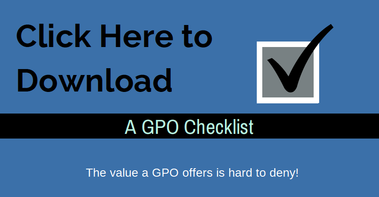
Year after year we hear the same hopeful resolutions on New Year's Day. However, instead of crowding the gym or listening to a hypnosis CD to rid yourself of that one bad habit, you could change the way your company manages its indirect spend and thus take control of its cost and realize savings opportunities. There are several options to manage indirect spend, as we mentioned in a previous blog, you can work internally on indirect spend, through a procurement outsourcing group or a group purchasing organization.
But knowing what your options are is just the first step. Next you need to know how they can or cannot benefit your company. Here are the pros and cons of each:
Internally sourcing
PROS
When managing your spend internally you will retain maximum flexibility. Internally sourcing gives you the ability to oversee each step and make all the decisions from beginning to end ensuring the entire process goes exactly how you intend it.
CONS
A disadvantage to internal sourcing is that a company may not have the market leverage to obtain significant discounts nor the experienced purchasing staff to manage the process correctly. Also, when the entire process is done within your company, there is less time for other projects. Outsourcing can free an organization from tedious and time-consuming tasks, so that they could concentrate on larger spend categories, go over unmanaged spend, and/or focus on compliance and consumption.
Procurement outsourcing group
PROS
The biggest benefit of a procurement outsourcing group is having a team of highly qualified workers who are determined to garner the best savings and guide your company in matters pertaining to process and policy compliance. Outsourcing with a procurement outsourcing group will give your employees the opportunity to focus on core business processes. By outsourcing low-value activities, internal procurement teams can focus the majority of their efforts on large, strategic deals that deliver greater savings.
CONS
One major aspect that may turn you away from a procurement group is that this type of outsourcing typically has a fee associated with it. The cost usually consist of an upfront fee plus part of the savings. Another thing to consider is there are fewer opportunities to oversee the day-to-day purchasing activities. It's likely that company employees may have a more thorough understanding of the industry, and their vested interests may mean they are more likely to make decisions in accordance with the company's goals. Along with not being able to oversee purchasing activities, there becomes a layer between the company and the supplier. While some may find this to be an advantage, there are many reasons to keep a good relationship with the supplier.
Group purchasing organization
PROS
A GPO will not only use their marketing knowledge of which suppliers are best for each product, but will combine your spend with other members causing savings that could not be reached alone. The contractual agreements offered when becoming a GPO member offers protection to all parties and is always tailored based on the member's needs.
CONS
As seen mostly with outsourcing, there is little opportunity for micromanagement of the category from your company. However, with service contracts and continued contact with suppliers, it is the most input you could have other than sourcing internally. Also, depending on how many categories you wish to source, there may be trouble finding a GPO that supports each and every category.
Whether you are actively seeking to outsource your indirect spend or curious to see how it can benefit your company, we welcome you to browse the CoVest Sourcing Network website, www.covest.com or call us with any inquires 216.325.5128
Image provided by Flickr user: MarwaMorgan
Interested to see if a GPO is right for you? Complete our GPO checklist and find out!




